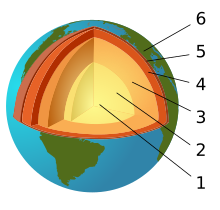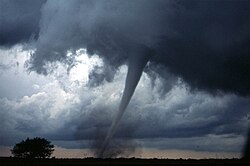



Love is any of a number of emotions related to a sense of strong affection[1] and attachment. The word love can refer to a variety of different feelings, states, and attitudes, ranging from generic pleasure ("I loved that meal") to intense interpersonal attraction ("I love my wife"). This diversity of uses and meanings, combined with the complexity of the feelings involved, makes love unusually difficult to consistently define, even compared to other emotional states.
As an abstract concept, love usually refers to a deep, ineffable feeling of tenderly caring for another person. Even this limited conception of love, however, encompasses a wealth of different feelings, from the passionate desire and intimacy of romantic love to the nonsexual emotional closeness of familial and platonic love[2] to the profound oneness or devotion of religious love.[3] Love in its various forms acts as a major facilitator of interpersonal relationships and, owing to its central psychological importance, is one of the most common themes in the creative arts.
Contents[hide] |
Definitions
| Part of a series on Love |
| Basic Aspects |
|---|
| Charity |
| Human bonding |
| Chemical basis |
| Religious views |
| Philosophy of love |
| Historically |
| Courtly love |
| Types of emotion |
| Eroticism |
| Platonic love |
| Familial love |
| Romance |
| See also |
| Limerence |
| Love sickness |
| Human sexuality |
| Unrequited love |
| Valentine's Day |
| Sexual intercourse |
| Interpersonal relationship |

The English word "love" can have a variety of related but distinct meanings in different contexts. Often, other languages use multiple words to express some of the different concepts that English relies mainly on "love" to encapsulate; one example is the plurality of Greek words for "love." Cultural differences in conceptualizing love thus make it doubly difficult to establish any universal definition.[4]
Although the nature or essence of love is a subject of frequent debate, different aspects of the word can be clarified by determining what isn't love. As a general expression of positive sentiment (a stronger form of like), love is commonly contrasted with hate (or neutral apathy); as a less sexual and more emotionally intimate form of romantic attachment, love is commonly contrasted with lust; and as an interpersonal relationship with romantic overtones, love is commonly contrasted with friendship, although other definitions of the word love may be applied to close friendships in certain contexts.
When discussed in the abstract, love usually refers to interpersonal love, an experience felt by a person for another person. Love often involves caring for or identifying with a person or thing, including oneself (cf. narcissism). In addition to cross-cultural differences in understanding love, ideas about love have also changed greatly over time. Some historians date modern conceptions of romantic love to courtly Europe during or after the Middle Ages, although the prior existence of romantic attachments is attested by ancient love poetry.[5]
Because of the complex and abstract nature of love, discourse on love is commonly reduced to a thought-terminating cliché, and there are a number of common proverbs regarding love, from Virgil's "Love conquers all" to the Beatles' "All you need is love." St. Thomas Aquinas, following Aristotle, defines love as "to will the good of another."[6] Bertrand Russell describes love as a condition of "absolute value," as opposed to relative value. Philosopher Gottfried Leibniz said that love is "to be delighted by the happiness of another."[7]
Love is sometimes referred to as being the "international language", overriding cultural and linguistic divisions.
Impersonal love
A person can be said to love an object, principle, or goal if they value it greatly and are deeply committed to it. Similarly, compassionate outreach and volunteer workers' "love" of their cause may sometimes be borne not of interpersonal love, but impersonal love coupled with altruism and strong political convictions. People can also "love" material objects, animals, or activities if they invest themselves in bonding or otherwise identifying with those things. If sexual passion is also involved, this condition is called paraphilia.[8]
Interpersonal love
Interpersonal love refers to love between human beings. It is a more potent sentiment than a simple liking for another. Unrequited love refers to those feelings of love that are not reciprocated. Interpersonal love is most closely associated with interpersonal relationships. Such love might exist between family members, friends, and couples. There are also a number of psychological disorders related to love, such as erotomania.
Throughout history, philosophy and religion have done the most speculation on the phenomenon of love. In the last century, the science of psychology has written a great deal on the subject. In recent years, the sciences of evolutionary psychology, evolutionary biology, anthropology, neuroscience, and biology have added to the understanding of the nature and function of love.
Chemical basis
Biological models of sex tend to view love as a mammalian drive, much like hunger or thirst.[9] Helen Fisher, a leading expert in the topic of love, divides the experience of love into three partly overlapping stages: lust, attraction, and attachment. Lust exposes people to others; romantic attraction encourages people to focus their energy on mating; and attachment involves tolerating the spouse (or indeed the child) long enough to rear a child into infancy.
Lust is the initial passionate sexual desire that promotes mating, and involves the increased release of chemicals such as testosterone and estrogen. These effects rarely last more than a few weeks or months. Attraction is the more individualized and romantic desire for a specific candidate for mating, which develops out of lust as commitment to an individual mate forms. Recent studies in neuroscience have indicated that as people fall in love, the brain consistently releases a certain set of chemicals, including pheromones, dopamine, norepinephrine, and serotonin, which act in a manner similar to amphetamines, stimulating the brain's pleasure center and leading to side effects such as increased heart rate, loss of appetite and sleep, and an intense feeling of excitement. Research has indicated that this stage generally lasts from one and a half to three years.[10]
Since the lust and attraction stages are both considered temporary, a third stage is needed to account for long-term relationships. Attachment is the bonding that promotes relationships lasting for many years and even decades. Attachment is generally based on commitments such as marriage and children, or on mutual friendship based on things like shared interests. It has been linked to higher levels of the chemicals oxytocin and vasopressin to a greater degree than short-term relationships have.[10] Enzo Emanuele and coworkers reported the protein molecule known as the nerve growth factor (NGF) has high levels when people first fall in love, but these return to previous levels after one year. [11]
Psychological basis
Psychology depicts love as a cognitive and social phenomenon. Psychologist Robert Sternberg formulated a triangular theory of love and argued that love has three different components: intimacy, commitment, and passion. Intimacy is a form in which two people share confidences and various details of their personal lives, and is usually shown in friendships and romantic love affairs. Commitment, on the other hand, is the expectation that the relationship is permanent. The last and most common form of love is sexual attraction and passion. Passionate love is shown in infatuation as well as romantic love. All forms of love are viewed as varying combinations of these three components. American psychologist Zick Rubin seeks to define love by psychometrics. His work states that three factors constitute love: attachment, caring, and intimacy.[12] [13]
Following developments in electrical theories such as Coulomb's law, which showed that positive and negative charges attract, analogs in human life were developed, such as "opposites attract." Over the last century, research on the nature of human mating has generally found this not to be true when it comes to character and personality—people tend to like people similar to themselves. However, in a few unusual and specific domains, such as immune systems, it seems that humans prefer others who are unlike themselves (e.g., with an orthogonal immune system), since this will lead to a baby that has the best of both worlds.[14] In recent years, various human bonding theories have been developed, described in terms of attachments, ties, bonds, and affinities.
Some Western authorities disaggregate into two main components, the altruistic and the narcissistic. This view is represented in the works of Scott Peck, whose work in the field of applied psychology explored the definitions of love and evil. Peck maintains that love is a combination of the "concern for the spiritual growth of another," and simple narcissism.[15] In combination, love is an activity, not simply a feeling.
Comparison of scientific models
Biological models of love tend to see it as a mammalian drive, similar to hunger or thirst.[9] Psychology sees love as more of a social and cultural phenomenon. There are probably elements of truth in both views. Certainly love is influenced by hormones (such as oxytocin), neurotrophins (such as NGF), and pheromones, and how people think and behave in love is influenced by their conceptions of love. The conventional view in biology is that there are two major drives in love: sexual attraction and attachment. Attachment between adults is presumed to work on the same principles that lead an infant to become attached to its mother. The traditional psychological view sees love as being a combination of companionate love and passionate love. Passionate love is intense longing, and is often accompanied by physiological arousal (shortness of breath, rapid heart rate); companionate love is affection and a feeling of intimacy not accompanied by physiological arousal.
Studies have shown that brain scans of those infatuated by love display a resemblance to those with a mental illness. Love creates activity in the same area of the brain where hunger, thirst, and drug cravings create activity. New love, therefore, could possibly be more physical than emotional. Over time, this reaction to love mellows, and different areas of the brain are activated, primarily ones involving long-term commitments.
Cultural views
Persian
Rumi, Hafez and Sa'di are icons of the passion and love that the Persian culture and language present. The Persian word for love is eshgh, deriving from the Arabic ishq. In the Persian culture, everything is encompassed by love and all is for love, starting from loving friends and family, husbands and wives, and eventually reaching the divine love that is the ultimate goal in life. Over seven centuries ago, Sa'di wrote:
-
-
-
- The children of Adam are limbs of one body
- Having been created of one essence.
- When the calamity of time afflicts one limb
- The other limbs cannot remain at rest.
- If you have no sympathy for the troubles of others
- You are not worthy to be called by the name of "man."
-
-
Chinese and other Sinic cultures

 "Ai," the traditional Chinese character for love (愛) consists of a heart (middle) inside of "accept," "feel," or "perceive," which shows a graceful emotion. It can also be interpreted as a hand offering ones heart to another hand.
"Ai," the traditional Chinese character for love (愛) consists of a heart (middle) inside of "accept," "feel," or "perceive," which shows a graceful emotion. It can also be interpreted as a hand offering ones heart to another hand.Two philosophical underpinnings of love exist in the Chinese tradition, one from Confucianism which emphasized actions and duty while the other came from Mohism which championed a universal love. A core concept to Confucianism is Ren ("benevolent love", 仁), which focuses on duty, action and attitude in a relationship rather than love itself. In Confucianism, one displays benevolent love by performing actions such as filial piety from children, kindness from parent, loyalty to the king and so forth.
The concept of Ai (愛) was developed by the Chinese philosopher Mozi in the 4th century BC in reaction to Confucianism's benevolent love. Mozi tried to replace what he considered to be the long-entrenched Chinese over-attachment to family and clan structures with the concept of "universal love" (jiān'ài, 兼愛). In this, he argued directly against Confucians who believed that it was natural and correct for people to care about different people in different degrees. Mozi, by contrast, believed people in principle should care for all people equally. Mohism stressed that rather than adopting different attitudes towards different people, love should be unconditional and offered to everyone without regard to reciprocation, not just to friends, family and other Confucian relations. Later in Chinese Buddhism, the term Ai (愛) was adopted to refer to a passionate caring love and was considered a fundamental desire. In Buddhism, Ai was seen as capable or being either selfish or selfless, the latter being a key element towards enlightenment.
In contemporary Chinese, Ai (愛) is often used as the equivalent of the Western concept of love. Ai is used as both a verb (e.g. wo ai ni 我愛你, or "I love you") and a noun (such as aiqing 愛情, or "romantic love"). However, due to the influence of Confucian Ren, the phrase ‘Wo ai ni’ (I love you) carries with it a very specific sense of responsibility, commitment and loyalty. Instead of frequently saying "I love you" as in some Western societies, the Chinese are more likely to express feelings of affection in a more casual way. Consequently, "I like you" (Wo xihuan ni, 我喜欢你) is a more common way of expressing affection in Chinese; it is more playful and less serious.[16] This is also true in Japanese (suki da, 好きだ). The Chinese are also more likely to say "I love you" in English or other foreign languages than they would in their mother tongue.
Japanese
In Japanese Buddhism, ai (愛) is passionate caring love, and a fundamental desire. It can develop towards either selfishness or selflessness and enlightenment. Amae (甘え), a Japanese word meaning "indulgent dependence," is part of the child-rearing culture of Japan. Japanese mothers are expected to hug and indulge their children, and children are expected to reward their mothers by clinging and serving. Some sociologists have suggested that Japanese social interactions in later life are modeled on the mother-child amae.
Ancient Greek
Greek distinguishes several different senses in which the word "love" is used. For example, Ancient Greek has the words philia, eros, agape, storge, and xenia. However, with Greek (as with many other languages), it has been historically difficult to separate the meanings of these words totally. At the same time, the Ancient Greek text of the Bible has examples of the verb agapo having the same meaning as phileo.
Agape (ἀγάπη agápē) means love in modern-day Greek. The term s'agapo means I love you in Greek. The word agapo is the verb I love. It generally refers to a "pure," ideal type of love, rather than the physical attraction suggested by eros. However, there are some examples of agape used to mean the same as eros. It has also been translated as "love of the soul."
Eros (ἔρως érōs) (from the Greek deity Eros) is passionate love, with sensual desire and longing. The Greek word erota means in love. Plato refined his own definition. Although eros is initially felt for a person, with contemplation it becomes an appreciation of the beauty within that person, or even becomes appreciation of beauty itself. Eros helps the soul recall knowledge of beauty and contributes to an understanding of spiritual truth. Lovers and philosophers are all inspired to seek truth by eros. Some translations list it as "love of the body."
Philia (φιλία philía), a dispassionate virtuous love, was a concept developed by Aristotle. It includes loyalty to friends, family, and community, and requires virtue, equality, and familiarity. Philia is motivated by practical reasons; one or both of the parties benefit from the relationship. It can also mean "love of the mind."
Storge (στοργή storgē) is natural affection, like that felt by parents for offspring.
Xenia (ξενία xenía), hospitality, was an extremely important practice in Ancient Greece. It was an almost ritualized friendship formed between a host and his guest, who could previously have been strangers. The host fed and provided quarters for the guest, who was expected to repay only with gratitude. The importance of this can be seen throughout Greek mythology—in particular, Homer's Iliad and Odyssey.
Turkish (Shaman & Islamic)
In Turkish, the word "love" comes up with several meanings. A person can love a god, a person, parents, or family. But that person can "love" just one person from the opposite sex, which they call the word "aşk." Aşk is a feeling for to love, or being "in love" (Aşık), as it still is in Turkish today. The Turks used this word just for their loves in a romantic or sexual sense. If a Turk says that he is in love (Aşık) with somebody, it is not a love that a person can feel for his or her parents; it is just for one person, and it indicates a huge infatuation. The word is also common for Turkic languages, such as Azerbaijani (eşq) and Kazakh (ғашық).
Ancient Roman (Latin)
The Latin language has several different verbs corresponding to the English word "love." Amāre is the basic word for to love, as it still is in Italian today. The Romans used it both in an affectionate sense as well as in a romantic or sexual sense. From this verb come amans—a lover, amator, "professional lover," often with the accessory notion of lechery—and amica, "girlfriend" in the English sense, often as well being applied euphemistically to a prostitute. The corresponding noun is amor (the significance of this term for the Romans is well illustrated in the fact, that the name of the City, Rome—in Latin: Roma—can be viewed as an anagram for amor, which was used as the secret name of the City in wide circles in ancient times),[17] which is also used in the plural form to indicate love affairs or sexual adventures. This same root also produces amicus—"friend"—and amicitia, "friendship" (often based to mutual advantage, and corresponding sometimes more closely to "indebtedness" or "influence"). Cicero wrote a treatise called On Friendship (de Amicitia), which discusses the notion at some length. Ovid wrote a guide to dating called Ars Amatoria (The Art of Love), which addresses, in depth, everything from extramarital affairs to overprotective parents.
Complicating the picture somewhat, Latin sometimes uses amāre where English would simply say to like. This notion, however, is much more generally expressed in Latin by placere or delectāre, which are used more colloquially, the latter used frequently in the love poetry of Catullus. Diligere often has the notion "to be affectionate for," "to esteem," and rarely if ever is used for romantic love. This word would be appropriate to describe the friendship of two men. The corresponding noun diligentia, however, has the meaning of "diligence" or "carefulness," and has little semantic overlap with the verb. Observare is a synonym for diligere; despite the cognate with English, this verb and its corresponding noun, observantia, often denote "esteem" or "affection." Caritas is used in Latin translations of the Christian Bible to mean "charitable love"; this meaning, however, is not found in Classical pagan Roman literature. As it arises from a conflation with a Greek word, there is no corresponding verb.
Religious views
Abrahamic religions
Judaism
In Hebrew, Ahava is the most commonly used term for both interpersonal love and love of God. Judaism employs a wide definition of love, both among people and between man and the Deity. Regarding the former, the Torah states, "Love your neighbor like yourself" (Leviticus 19:18). As for the latter, one is commanded to love God "with all your heart, with all your soul and with all your might" (Deuteronomy 6:5), taken by the Mishnah (a central text of the Jewish oral law) to refer to good deeds, willingness to sacrifice one's life rather than commit certain serious transgressions, willingness to sacrifice all of one's possessions, and being grateful to the Lord despite adversity (tractate Berachoth 9:5). Rabbinic literature differs as to how this love can be developed, e.g., by contemplating divine deeds or witnessing the marvels of nature. As for love between marital partners, this is deemed an essential ingredient to life: "See life with the wife you love" (Ecclesiastes 9:9). The biblical book Song of Solomon is considered a romantically phrased metaphor of love between God and his people, but in its plain reading, reads like a love song. The 20th-century Rabbi Eliyahu Eliezer Dessler is frequently quoted as defining love from the Jewish point of view as "giving without expecting to take" (from his Michtav me-Eliyahu, Vol. 1).
Christianity

The Christian understanding is that love comes from God. The love of man and woman—eros in Greek—and the unselfish love of others (agape), are often contrasted as "ascending" and "descending" love, respectively, but are ultimately the same thing.[18]
There are several Greek words for "love" that are regularly referred to in Christian circles.
- Agape: In the New Testament, agapē is charitable, selfless, altruistic, and unconditional. It is parental love, seen as creating goodness in the world; it is the way God is seen to love humanity, and it is seen as the kind of love that Christians aspire to have for one another.
- Phileo: Also used in the New Testament, phileo is a human response to something that is found to be delightful. Also known as "brotherly love."
- Two other words for love in the Greek language, eros (sexual love) and storge (child-to-parent love), were never used in the New Testament.
Christians believe that to Love God with all your heart, mind, and strength and Love your neighbor as yourself are the two most important things in life (the greatest commandment of the Jewish Torah, according to Jesus; cf. Gospel of Mark chapter 12, verses 28–34). Saint Augustine summarized this when he wrote "Love God, and do as thou wilt."
The Apostle Paul glorified love as the most important virtue of all. Describing love in the famous poem in 1 Corinthians, he wrote, "Love is patient, love is kind. It does not envy, it does not boast, it is not proud. It is not rude, it is not self-seeking, it is not easily angered, it keeps no record of wrongs. Love does not delight in evil but rejoices with the truth. It always protects, always trusts, always hopes, and always perseveres." (1 Cor. 13:4–7, NIV)
The Apostle John wrote, "For God so loved the world that he gave his one and only Son, that whoever believes in him shall not perish but have eternal life. For God did not send his Son into the world to condemn the world, but to save the world through him. Whoever believes in him is not condemned, but whoever does not believe stands condemned already because he has not believed in the name of God's one and only Son." (John 3:16–18, NIV) John also wrote, "Dear friends, let us love one another for love comes from God. Everyone who loves has been born of God and knows God. Whoever does not love does not know God, because God is love." (1 John 4:7–8, NIV)
Saint Augustine says that one must be able to decipher the difference between love and lust. Lust, according to Saint Augustine, is an overindulgence, but to love and be loved is what he has sought for his entire life. He even says, “I was in love with love.” Finally, he does fall in love and is loved back, by God. Saint Augustine says the only one who can love you truly and fully is God, because love with a human only allows for flaws such as “jealousy, suspicion, fear, anger, and contention.” According to Saint Augustine, to love God is “to attain the peace which is yours.” (Saint Augustine's Confessions)
Christian theologians see God as the source of love, which is mirrored in humans and their own loving relationships. Influential Christian theologian C.S. Lewis wrote a book called The Four Loves. Benedict XVI wrote his first encyclical on "God is love." He said that a human being, created in the image of God, who is love, is able to practice love; to give himself to God and others (agape) and by receiving and experiencing God's love in contemplation (eros). This life of love, according to him, is the life of the saints such as Teresa of Calcutta and the Blessed Virgin Mary and is the direction Christians take when they believe that God loves them.[18]
Islam and Arab
In a sense, love does encompass the Islamic view of life as universal brotherhood that applies to all who hold the faith. There are no direct references stating that God is love, but amongst the 99 names of God (Allah), there is the name Al-Wadud, or "the Loving One," which is found in Surah 11:90 as well as Surah 85:14. It refers to God as being "full of loving kindness." All who hold the faith have God's love, but to what degree or effort he has pleased God depends on the individual itself.
Ishq, or divine love, is the emphasis of Sufism. Sufis believe that love is a projection of the essence of God to the universe. God desires to recognize beauty, and as if one looks at a mirror to see oneself, God "looks" at itself within the dynamics of nature. Since everything is a reflection of God, the school of Sufism practices to see the beauty inside the apparently ugly. Sufism is often referred to as the religion of love. God in Sufism is referred to in three main terms, which are the Lover, Loved, and Beloved, with the last of these terms being often seen in Sufi poetry. A common viewpoint of Sufism is that through love, humankind can get back to its inherent purity and grace. The saints of Sufism are infamous for being "drunk" due to their love of God; hence, the constant reference to wine in Sufi poetry and music.
Eastern religions
Buddhism
In Buddhism, Kāma is sensuous, sexual love. It is an obstacle on the path to enlightenment, since it is selfish. Karuṇā is compassion and mercy, which reduces the suffering of others. It is complementary to wisdom and is necessary for enlightenment. Adveṣa and mettā are benevolent love. This love is unconditional and requires considerable self-acceptance. This is quite different from ordinary love, which is usually about attachment and sex and which rarely occurs without self-interest. Instead, in Buddhism it refers to detachment and unselfish interest in others' welfare.
The Bodhisattva ideal in Mahayana Buddhism involves the complete renunciation of oneself in order to take on the burden of a suffering world. The strongest motivation one has in order to take the path of the Bodhisattva is the idea of salvation within unselfish, altruistic love for all sentient beings.
Hinduism
In Hinduism, kāma is pleasurable, sexual love, personified by the god Kamadeva. For many Hindu schools, it is the third end (artha) in life. Kamadeva is often pictured holding a bow of sugar cane and an arrow of flowers; he may ride upon a great parrot. He is usually accompanied by his consort Rati and his companion Vasanta, lord of the spring season. Stone images of Kaama and Rati can be seen on the door of the Chenna Keshava temple at Belur, in Karnataka, India. Maara is another name for kāma.
In contrast to kāma, prema – or prem – refers to elevated love. Karuna is compassion and mercy, which impels one to help reduce the suffering of others. Bhakti is a Sanskrit term, meaning "loving devotion to the supreme God." A person who practices bhakti is called a bhakta. Hindu writers, theologians, and philosophers have distinguished nine forms of bhakti, which can be found in the Bhagavata Purana and works by Tulsidas. The philosophical work Narada Bhakti Sutras, written by an unknown author (presumed to be Narada), distinguishes eleven forms of love.




















